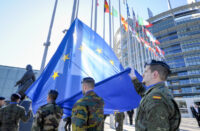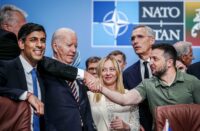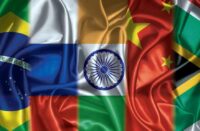In 2007 General Wesley Clarke revealed the Pentagon’s post-9/11 plan to overthrow “seven countries in five years: Iraq, and then Syria, Lebanon, Libya, Somalia, Sudan and, finishing off, Iran.”
In the 7 October edition of the Tory Spectator, J. R. Bradley outlined the now failed plot against Syria: “our cynical effort [was] to install a Sunni regime in Damascus by adopting the Afghanistan playbook from the 1980s. We would train, fund and arm jihadis, foreign and domestic, in partnership with the Gulf Arab despots.” This was also confirmed recently by the former Qatari prime minister in a television interview.
Once Syria fell, weaponry from Iran to support the anti-imperialist resistance in Lebanon, primarily Hezbollah, would be stopped, leading to an Israeli invasion of Lebanon. Next would be Tehran.
President Obama threatened to attack Damascus in September 2013. Syria was to be the next Libya. That was why Margaretta D’Arcy and I blocked Shannon Airport’s runway, demanding “Hands off Syria.” Shannon Airport would be used to transport the weaponry destined to slaughter Syrians.
In late October I joined international peace activists on a tour of Syria. The trip would take us to Damascus, Maaloula, Homs, and Aleppo. The group included Clare Daly TD, Mick Wallace TD, Dave Donnellan and Edward Horgan of Shannonwatch.
EU sanctions mean no direct flights to Syria. Therefore Beirut was our first destination on the biblical road to Damascus by taxi.
Encountering numerous checkpoints, it was 6 p.m. and dark when we reached our hotel in Damascus’s old city. Security was tight. In the hotel we heard the distant sounds of mortar fire. A mile away two jihadist groups still occupy the suburb of Jobar.
However, outside the hotel that Thursday evening it was like any Irish city at a weekend. The place was teeming with young people out for the night, the narrow road bumper to bumper with cars, Arab music booming.
Thursday night is the start of the Muslim weekend. The seriously secular were letting their hair down. We retired to a beer garden. Sleeping proved difficult, not because of our proximity to the jihadists but from the noise from the neighbouring nightclubs.
By daylight, armed soldiers were very visible, standing or sitting at street corners nursing AK47s. It was not threatening but reassuring. Car boots were searched at permanent checkpoints and even sporadic checking of males’ identity cards—all very reminiscent of life in west Belfast during the “Troubles,” minus the animosity.
Everyone was extremely friendly. A simple Salaam (“Peace” or “Hello”), hand on heart, is gladly reciprocated. Regularly, passers-by would greet us with “welcome” or “thank you.” Since the war, tourists are rare. Before 2011, tourism accounted for 14 per cent of GDP.
In the cafés, people were delighted to talk and pleased we had made the effort to visit Syria. One man explained how Damascus had nearly fallen, but “the people saved it,” confirming J. R. Bradley’s view: “there was no popular revolution against Assad . . . The millions-strong demonstrations in Damascus were pro-regime.”
The cafés were also great for people-watching. Women, with or without hijabs, smoked water pipes along with male friends. One Syrian I met who had lived in Germany for more than fifty years would gladly return home permanently; only the idea of missing his family in Germany prevents him.
However, the war—almost won—is never far away. In every street, in every town, there are posters and photos of the martyrs who gave their lives opposing the jihadists. Very many times, from Damascus to Aleppo, I heard how backward rural Sunnis were bribed to succumb to the poisonous sectarian messages of Saudi Wahhabis and Qatari Muslim Brothers.
A visit to the main Sunni mosque in Damascus underlines the aberration of these sects. Inside the mosque stands a huge shrine to St John the Baptist. His severed head once lay on this spot. Sunni Muslims are not an enemy of Christianity.
Whether the Catholics in Maaloula would agree is debatable. This mountainous village is two-thirds Catholic. They speak Aramaic, the presumed language of Jesus. In early September 2013 Obama’s threats to bomb Syria signalled a jihadi attack on the village. The Sunni villagers did not warn their Catholic neighbours. Jihadists desecrated their church, looted their modest homes, killed three villagers and kidnapped six, all later murdered.
Kidnapping and looting were a dominant theme everywhere. Armenian towns along the Turkish border, for example, had been systematically looted by jihadists, from taking light-bulbs to dismantling an entire power station, bringing it all to Turkey.
When Raqqa, the ISIS “capital,” fell there was joy. But now we know the United States allowed the IS leadership safe passage.
It was with their victims that we had the most haunting meeting: traumatised refugees, Shia families from the pro-government towns of Foua and Kafraya. Last April a deal was struck whereby inhabitants of these two towns under siege by IS would be freed, and in return the same would happen to two jihadist-controlled towns. Instead IS and its “White Helmets” detonated a car bomb beside the buses, killing more than a hundred people, including thirty-nine children.
To add to the anguish, fifty-four children were kidnapped and are now held in Turkey. One child returned after payment of a ransom of $100,000.
A visit to two multidenominational primary schools in Homs—the so-called cradle of the Syrian “revolution”—was equally disturbing. Suicide bombers had targeted these schools, slaughtering thirty children and many parents. In the entrance hall were photos of each child murdered.
Here, young girls greeted us, movingly singing in Arabic the “Ode to Joy” from the final movement of Beethoven’s 9th Symphony: “Alle Menschen werden Brüder / All people are joined in brotherhood.” The EU has adopted the “Ode to Joy” as its anthem—inappropriate, considering its stringent sanctions against Syria, which a leaked UN memo in 2016 noted was making it more difficult for foodstuffs, fuel and medicines to reach the people. Thus the EU sides with the jihadist conspiracy.
It is impossible to relate all my Syrian experiences here: trundling along tarmacked roads, through liberated desert, to Aleppo, seeing yellow Hezbollah flags fluttering over what looked like ancient ring-forts, being struck in Aleppo and Homs by the destruction but realising that it can be rebuilt—unlike the mangled human remains—or standing on the roof of Aleppo’s post office, where a “moderate” rebel had thrown public-service workers to their deaths.
Beside me on the return flight from Beirut to Frankfurt was a young Syrian chemist, working for a company in Germany. We chatted. Going home, she had observed how accustomed people had become to war. Concerning Assad, she was direct: “Outsiders talk of replacing President Assad, but over the past seven years no realistic alternative has emerged capable of taking his place. He must remain our president.”





